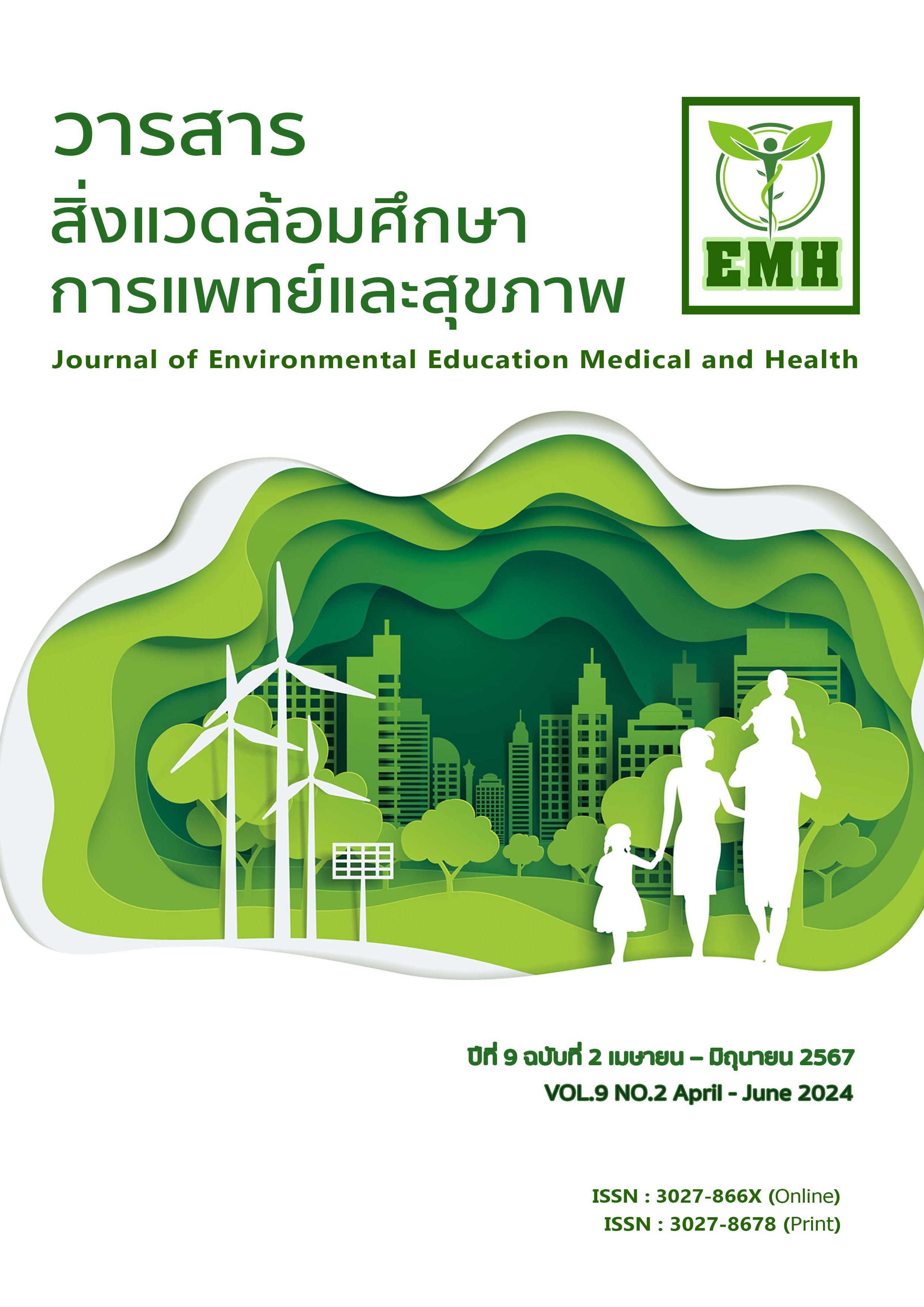การพัฒนาและการใช้แบบตรวจสอบรายการความปลอดภัยของผู้ป่วยที่ได้รับบริการระงับความรู้สึกเพื่อการพัฒนาคุณภาพและความปลอดภัยของผู้ป่วยที่ได้รับบริการระงับความรู้สึก ตามการรับรู้ของวิสัญญีพยาบาลในโรงพยาบาลทั่วไป
คำสำคัญ:
แบบตรวจสอบรายการความการปลอดภัย, คุณภาพและความปลอดภัยของผู้ป่วย, การบริการระงับความรู้สึก, วิสัญญีพยาบาลบทคัดย่อ
การวิจัยครั้งนี้เป็นการวิจัยและพัฒนา (Research and Development) มีวัตถุประสงค์ดังนี้ 1) เพื่อพัฒนาแบบตรวจสอบรายการความปลอดภัยฯ 2) เพื่อประเมินผลการใช้แบบตรวจสอบรายการความปลอดภัยฯ 3) เพื่อศึกษาความพึงพอใจของบุคลากรในการนําแบบตรวจสอบรายการความปลอดภัยฯ ไปใช้ และ 4) เพื่อศึกษาปัญหาอุปสรรคและแนวทางการแก้ไขในการนําแบบตรวจสอบรายการความปลอดภัยของผู้ป่วยที่ได้รับบริการระงับความรู้สึกไปใช้ตามการรับรู้ของวิสัญญีพยาบาลในโรงพยาบาลทั่วไป กลุ่มตัวอย่างคือ พยาบาลวิสัญญีในโรงพยาบาลทั่วไป จำนวน 164 คน คำนวณจากสูตรของเครซซี่และมอร์แกน เครื่องมือวิจัยเป็นแบบสอบถามประมาณค่า 5 ระดับ ได้รับการตรวจสอบคุณภาพเครื่องมือวิจัยจากผู้ทรงคุณวุฒิจำนวน 7 คน ได้ค่าดัชนีความตรงเชิงเนื้อหาอยู่ระหว่าง 0.93-0.96 และค่าความเที่ยงโดยสูตรสัมประสิทธิ์แอลฟาของครอนบาคอยู่ระหว่าง 0.91-0.96 วิเคราะห์ข้อมูลด้วยสถิติพรรณนาและการวิเคราะห์เนื้อหา
ผลการวิจัยพบว่า ความเป็นไปได้ในการนําแบบตรวจสอบความปลอดภัยไปใช้อยู่ในระดับมาก (= 3.94, SD = .08) ปัญหาและอุปสรรคในการนำแบบตรวจสอบความปลอดภัยไปใช้อยู่ในระดับน้อยที่สุด (
=1.49, SD=.06) ช่วงที่ทำการศึกษาพบอุบัติการณ์การรั่วซึมสารน้ำออกนอกหลอดเลือดดำผู้ป่วยและบวมมากที่สุดจำนวน 14 ราย (ร้อยละ 0.28) รองลงมาพบภาวะหลอดลมหดเกร็งจำนวน 9 ราย (ร้อยละ 0.18) และพบภาวะเยื่อบุตาอักเสบจากการจัดท่าน้อยที่สุดจำนวน 1 ราย (ร้อยละ 0.02)
เอกสารอ้างอิง
Joint Commission for of Health Organization (JCAHO). Joint Commission International Accreditation standard for Hospital. 5th Edition. Library of Congress. 2017 [cited 2024 Jun 8]. Available from: http://www.jointcommissioninternationalaccreditation.org
World Health Organization (WHO). Atlas of eHealth country profiles: the use of eHealth in support of universal health coverage. 2016 [cited 2021 Apr 29]. Available from: https://www.who.int/publications/i/item/9789241565219
Melesse DY, Denu ZA, Kassahun HG, Agegnehu AF. The incidence of early post-operative hypoxemia and its contributing factors among patients underwent operation under anesthesia at University of Gondar comprehensive and specialized referral hospital, Gondar, North West Ethiopia, 2018. A prospective observational study. Int J Surg Open. 2020;22:38-46.
Ittichaikulthol W, Duangngoen P, Thamjamrassri T, Jiarpinitnun J. Risk factors of reintubation in post anesthetic care unit after general anesthesia in Ramathibodi Hospital. Thai J Anesthesiol. 2016;42(1):33-41.
กรมการแพทย์. จำนวนผู้ป่วยผ่าตัด หัตถการ จำแนกตามเพศและกลุ่มอายุ ปี พ.ศ. 2552. 2559 [cited 2024 Jun 8]. Available from: http://www.dms.moph.go.th/statreport/index.html
สมรัตน์ จารุลักษณานันท์, ยอดยิ่ง ปัญจสวัสดิ์วงศ์, ศิริพร ปิติมานะอารี, เทวรารักษ์ วีระวัฒภนนท์, วรินี เล็กประเสริฐ, ศศิกานต์ นิมานรัชต์, วราวุธ ภาพพิเศษพันธุ์. การศึกษาอัตราการเสียชีวิต และภาวะแทรกซ้อนทางวิสัญญีจากการรายงานอุบัติการณ์ในประเทศไทย (รายงานการวิจัย). กรุงเทพฯ: สถาบันวิจัยระบบสาธารณสุข; 2560.
Liberman JS, Slagle JM, Whitney G, Shotwell MS, Lorinc A, Porterfield E, et al. Incidence and classification of nonroutine events during anesthesia care. Anesthesiology. 2020;133(1):41-52. doi: http://dx.doi.org/10.1097/ALN.0000000000003336. PubMed PMID: 32404773.
Haugen AS, Waehle HV, Almeland SK, Harthug S, Sevdalis N, Eide GE, et al. Causal analysis of World Health Organization’s surgical safety checklist implementation quality and impact on care processes and patient outcomes: secondary analysis from a large stepped widge cluster randomized controlled trial in Norway. Ann Surg. 2019;269(2):283-90. doi: http://dx.doi.org/10.1097/SLA.0000000000002584. PubMed PMID: 29112512.
Saxena S, Krombach JW, Nahrwold DA, Pirracchio R. Anaesthesia-specific checklists: a systematic review of impact. Anaesth Crit Care Pain Med. 2020;39(1):65-73. doi: http://dx.doi.org/10.1016/j.accpm.2019.07.011. PubMed PMID: 31374366.
Soukup SM. Preface to section on evidence-based nursing practice. Nurs Clin North Am. 2000;35(2):xvii–xviii.
Krejcie RV, Morgan DW. Determining sample size for research activities. Educ Psychol Meas. 1970;30:607-610.
Association of Veterinary Anaesthetists. 2020 [cited 2024 Jun 8]. Available from: https://ava.eu.com
Polit DF, Beck CT. Nursing research: Generating and assessing evidence for nursing practice. 10th ed. Philadelphia, PA: Wolters Kluwer Health; 2017.
Johnson LJ, LaMontagne MJ. Using content analysis to examine the verbal or written communication of stakeholders within early intervention. J Early Interv. 1993;17(1):73-79.
Melnyk BM, Fineout-Overholt E. Evidence-based practice in nursing & healthcare: A guide to best practice. Philadelphia, PA: Lippincott Williams & Wilkins; 2005.
Ghaly RF, Kushnarev M, Pirvulescu I, Perciuleac Z, Candido KD, Knezevic NN. A novel checklist for anesthesia in neurosurgical cases. Surg Neurol Int. 2021;12:184.
Stephanie R, Nick S, Krishna S, Erik M, Shantanu R, Jochem C. A qualitative evaluation of the barriers and facilitators toward implementation of the WHO surgical safety checklist across hospitals in England. Ann Surg. 2015;1-11.
ศิริรัตน์ จึงสมาน. การวิเคราะห์ต้นทุนต่อหน่วยและต้นทุนกิจกรรมการพยาบาลผ่าตัด ห้องผ่าตัด โรงพยาบาลสุรินทร์. (วิทยานิพนธ์ปริญญามหาบัณฑิต). กรุงเทพฯ: จุฬาลงกรณ์มหาวิทยาลัย; 2558.





